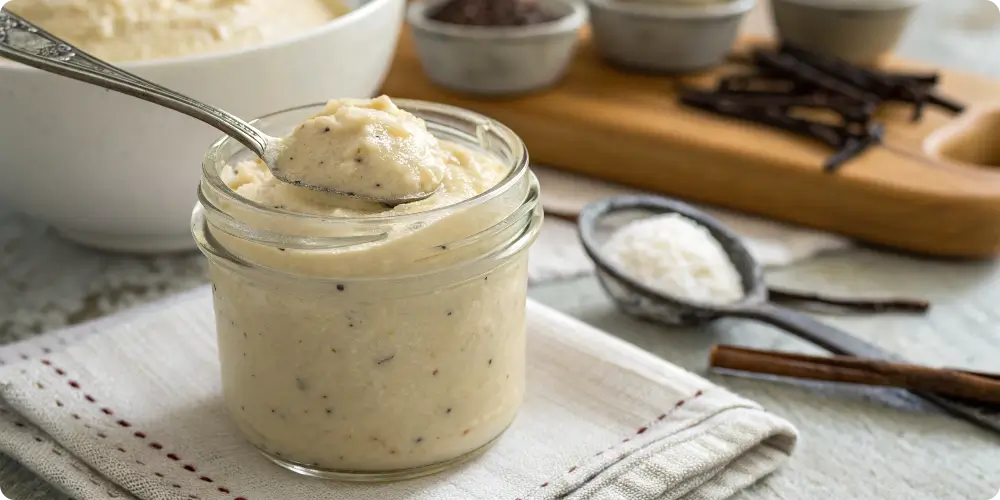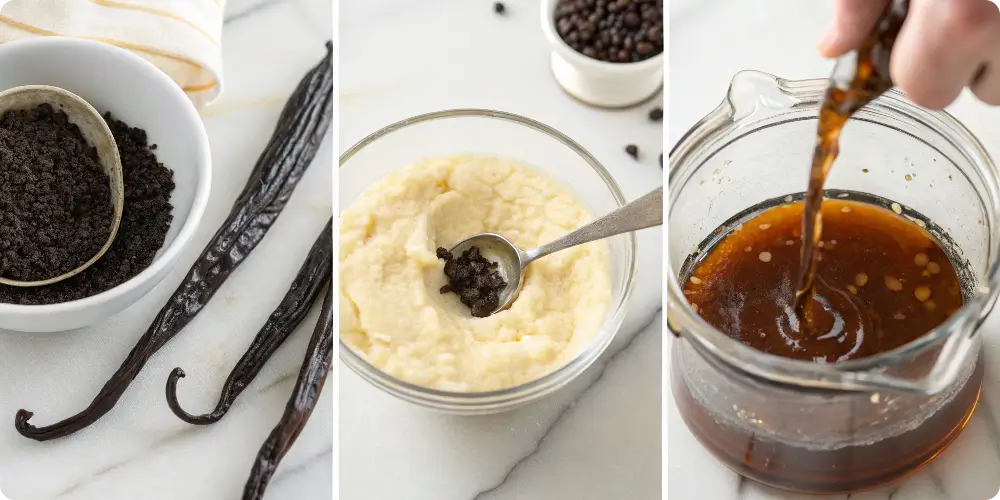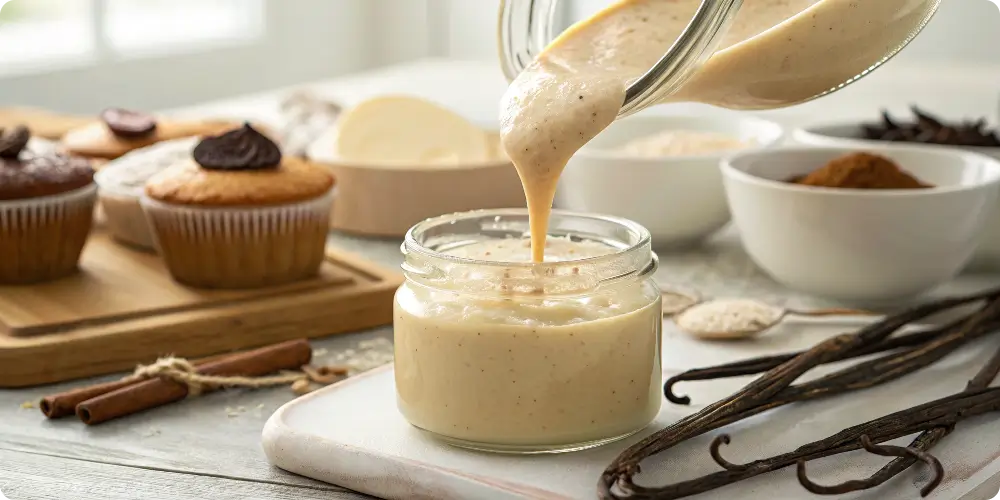Vanilla Paste Recipe
Vanilla Paste Recipe: How to Make a Rich, Aromatic Alternative to Extract
If you’re serious about baking or love clean-label, homemade ingredients, you need to try this vanilla paste recipe. It’s a thick, fragrant, spoonable alternative to vanilla extract, loaded with real vanilla bean specks and bold flavour that instantly elevates any dish.
At Tasty Plated, Chef Rachael swears by making your own vanilla paste. It’s easier than you think, uses only a few ingredients, and delivers way more flavour than most bottled options. Whether you’re stirring it into frosting, folding it into cake batter, or using it in your morning oatmeal, this rich paste adds warmth, depth, and those signature vanilla flecks that make desserts feel gourmet.
• What Is Vanilla Paste?
Vanilla paste (also called vanilla bean paste) is a concentrated form of vanilla that includes the flavourful seeds from the vanilla pod, suspended in a syrupy base. It’s thicker than extract, sweeter, and packs a visual and aromatic punch.
While extract is liquid and alcohol-based, paste is semi-viscous and speckled with real vanilla bean seeds, giving baked goods a visual appeal that screams “from scratch.”
Key Features:
Thick and spoonable consistency
Contains vanilla bean specks
Stronger and sweeter than vanilla extract
Great for custards, frostings, whipped cream, ice cream, and cakes

• Ingredients You’ll Need for Vanilla Paste
Making your own vanilla paste recipe is simple, clean, and much more affordable than store-bought versions. Here’s what you’ll need:
Essential Ingredients:
3–4 whole vanilla beans (Madagascar, Tahitian, or Bourbon)
¼ cup agave syrup, honey, or maple syrup (use corn syrup for a neutral flavour)
1 tbsp vanilla extract (to boost flavour and shelf life)
Optional:
1 tsp glycerine or food-grade gum (like xanthan) for extra thickness (not required)
Equipment:
Sharp knife
Small saucepan or bowl
High-speed blender or small food processor
Fine mesh strainer (optional)
Airtight jar for storage
• How to Make Vanilla Paste at Home (Step-by-Step)
Follow these simple steps to create your own vanilla paste recipe in under 30 minutes.
Step 1: Split and Scrape the Beans
Use a sharp knife to carefully split the vanilla beans lengthwise. Use the back of the blade to scrape out all the sticky seeds (a.k.a. vanilla caviar).
Step 2: Combine in Blender
Add the seeds and pods to a blender along with your sweetener of choice (agave, maple syrup, or corn syrup) and vanilla extract. Blend until smooth and thick. For a stronger paste, let it rest overnight before blending.
Step 3: Optional Straining
Strain through a fine mesh sieve if you want a smoother paste without fibrous pieces. Keep the strained bits and reuse in sugar or steeped recipes.
Step 4: Store
Pour into a clean, airtight glass jar. Label with the date. Store in the fridge for up to 6 months or freezer for longer shelf life.

• Chef Rachael’s Clean Vanilla Paste Method for Tasty Plated
At Tasty Plated, Chef Rachael is a big fan of clean pantry staples, especially when they outperform store-bought versions. Her vanilla paste recipe is free from artificial gums, preservatives, and added colouring. Just real ingredients, slow flavour, and lasting results.
Chef Rachael’s Tips:
Use grade B vanilla beans if available, they’re cheaper and just as flavourful
Let the paste rest 24 hours before first use for peak flavour
Add a touch of bourbon or dark rum for an extra layer of warmth
Always use dark glass jars for long-term storage and flavour protection
“Vanilla paste is the kind of ingredient that makes everything taste bakery-quality. Once you try it homemade, you’ll never go back.”
, Chef Rachael

• Table: Vanilla Paste vs. Extract vs. Powder
| Type | Texture | Flavor Strength | Visual Appeal | Best Uses |
|---|---|---|---|---|
| Vanilla Extract | Thin liquid | Medium | No specks | General baking, beverages |
| Vanilla Paste | Thick, syrupy | Strong | Visible bean flecks | Custards, frostings, sauces |
| Vanilla Powder | Fine dry powder | Mild to strong | Light specks (sometimes) | Dry baking mixes, coffee |
This breakdown shows why vanilla paste is a standout: strength, specks, and versatility.
• How to Use Vanilla Paste in Your Recipes
Because vanilla paste is concentrated, you don’t need much, but every drop delivers.
Use in:
Cakes and cupcakes
Buttercream and cream cheese frosting
Custards and puddings
Pancake or waffle batter
Ice cream and gelato
French toast and baked oatmeal
Homemade granola or yogurt bowls
How to Sub It In:
1 tsp vanilla extract = 1 tsp vanilla paste
For stronger flavour, use slightly less paste and taste-test
• Storage, Shelf Life, and Tips
Storage Tips:
Refrigerate after opening
Use a clean spoon to avoid contamination
Stir before use (it may settle over time)
Shelf Life:
Up to 6 months in the fridge
Up to 1 year frozen in ice cube trays (1 tsp per cube)
You can even reuse spent vanilla pods by blending them into sugar or adding them to syrups, honey, or homemade jams.
• FAQs About Vanilla Paste Recipe
1. Is vanilla paste stronger than extract?
Yes, vanilla paste has a more intense, rich flavour and includes the seeds, which add visual and taste depth.
2. Can I use imitation vanilla beans?
No, this recipe only works with real vanilla beans. Imitation products won’t deliver the same results.
3. Is this cheaper than buying it pre-made?
Absolutely. Store-bought vanilla paste can cost $10–$20 per 4 oz jar. DIY costs a fraction, especially if you buy beans in bulk.
4. Can I use sugar instead of syrup?
Not recommended. Syrup or honey keeps the paste smooth and preserves better.
5. Can I make it alcohol-free?
Yes, just omit the extract and use extra syrup. The flavour will be a bit softer.
6. How do I know if it’s gone bad?
Off smell, mold, or major colour change means it’s time to toss.
• Final Spoonful: Homemade Flavor That’s Better Than Bottled
This vanilla paste recipe is more than a trend, it’s a smart, flavour-packed staple that belongs in every baker’s pantry. It gives your recipes the depth, aroma, and real vanilla bean magic that extracts just can’t match.
At Tasty Plated, Chef Rachael brings ingredients back to their roots, simple, real, and made with care. Her vanilla paste is no exception. With just a few beans and pantry staples, you’ll have a homemade luxury that transforms desserts, breakfasts, and everything in between.
Try it once, and you’ll be hooked.